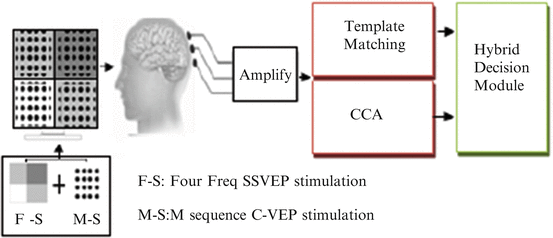Fig. 1
(a) c-VEP stimulation matrix. (b) SSVEP stimulation blocks
As shown in Fig. 1, four Rectangle background areas represent in four different frequencies flickering inside, with 16 targets were arranged as a 4 × 4 matrix (in Fig. 1a). Four flicking frequency (8 Hz, 9 Hz, 11 Hz, 12 Hz) was used to evoke SSVEP (in Fig. 1b), Four flicking frequency (60/9 Hz 60/8 Hz, 60/7 Hz, 60/5 Hz) was used in former experiment.
Each target was periodically modulated by a 63-bit binary m-sequence that could evoke C-VEP. Time lag between two consecutive targets is set to four frames, and the used modulation sequences in one period were the same m-sequence for all targets. The experiment studied the feasibility of the hybrid BCI systems based on c-VEP and SSVEP. SSVEP stimulate was used as the back ground to divide the screen into four regions, each region used M pseudo-random sequence to divide into 16 targets. There were total 64 targets in this system. Canonical correlation analysis (CCA) method was performed to extract frequency information associated with the SSVEP. A template matching method was used for target identification of c-VEP [1, 2].
As shown in Fig. 2, the ellipse mask is c-VEP stimulation, the Rectangle background is SSVEP stimulation. CCA: canonical correlation analysis method.


Fig. 2
A c-VEP/SSVEP BCI hybrid system structure diagraph
A template matching method is generally used for target identification. To obtain the template, a training stage must be implemented. The steps of target identification are as follows:

1.
In the training stage, the user is instructed to fixate on one of k targets, with the fixation target denoted by T0. During N stimulation cycles, EEG data Xn, n51, 2…N is collected.
2.
A template T is obtained by averaging over N cycles.


(1)
3.
The templates of all targets are obtained by shifting T:


(2)
4.
Get Clinical Tree app for offline access
For a segment of EEG data x, the correlation coefficient between x and the template T is calculated as:









